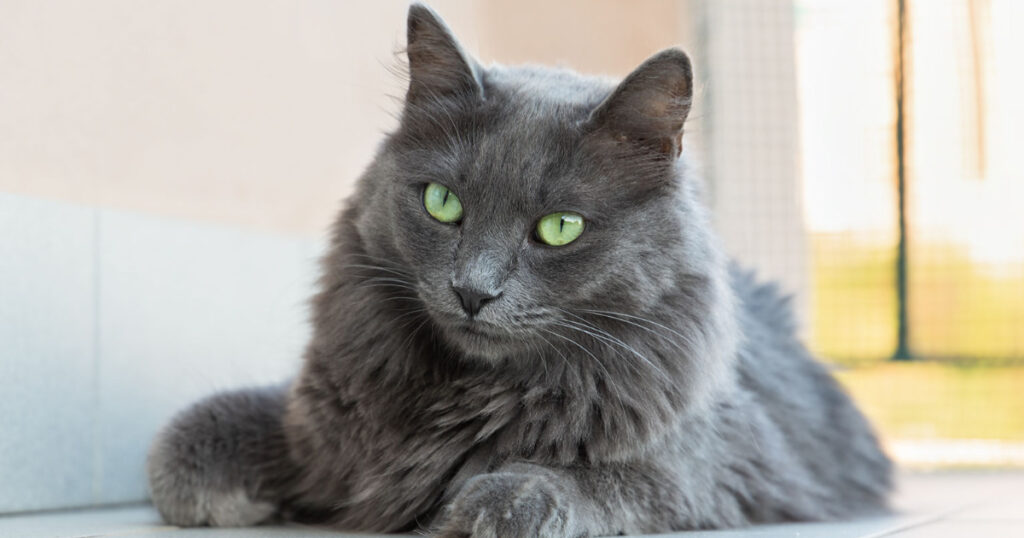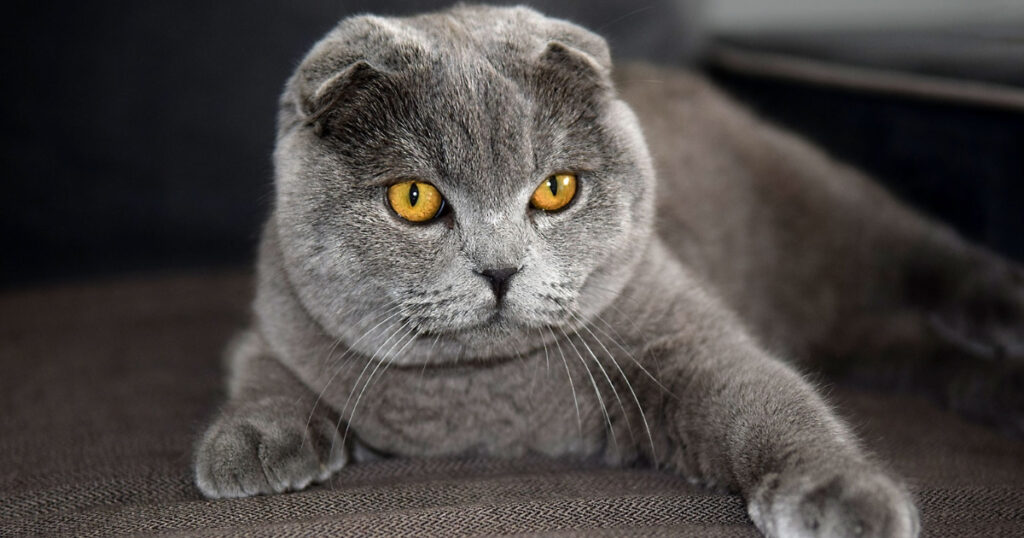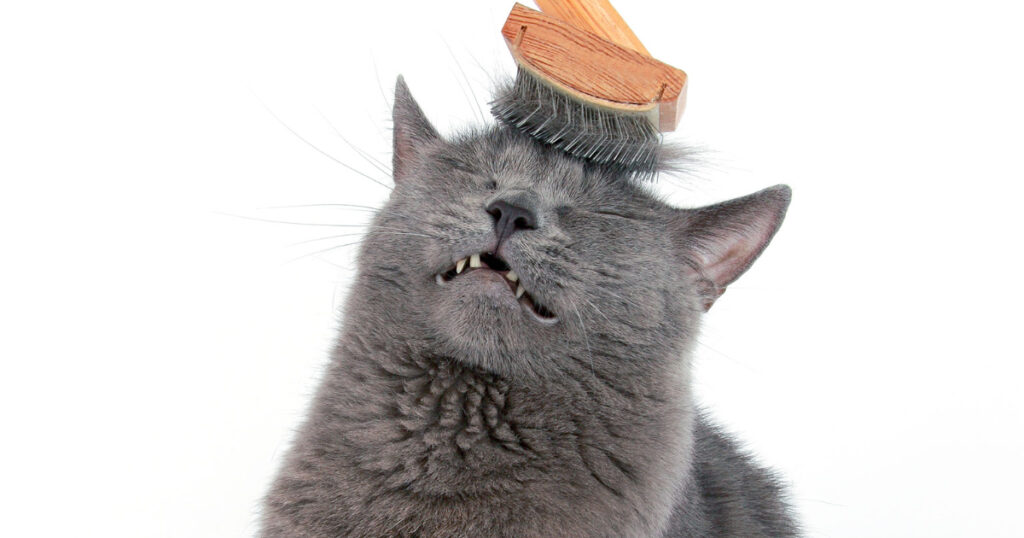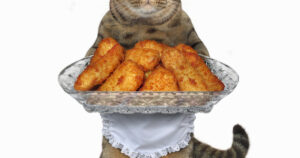Gray cats charm many cat lovers with their mysterious and elegant looks. Their green or yellow eyes stand out against their gray coats.
Many cultures have admired these cats throughout history. Some even see them as a sign of luck and richness.
Today, many people adore gray cats. They are hard to resist whether you have owned cats for a long time or are new to feline friends.
There are many kinds of them, each with features and personalities.

The most popular are the Russian Blue, British Shorthair, Nebelung, Korat, Chartreux, and Domestic Shorthair and Longhair.
There are also some rare ones, such as the Egyptian Mau, Scottish Fold, and Carthusian.
The Genetics Behind Gray Cats
Feline coat colors depend on genes that control pigments in fur. The primary pigments are black or brown and orange or red. Cats get two color genes, one from each parent.
These genes can be dominant or recessive, which affects the coat color. Gray cats often have a genetic mutation called the dilution gene. It changes how pigment spreads in the fur.
Detailed Look at Popular Gray Cat Breeds
1. Russian Blue

The Russian Blue breed has a beautiful silvery-blue coat and bright green eyes.
It comes from Russia and has a gentle, loving personality.
These cats are intelligent and calm, and they love their human families.
They also like to play and have fun, sometimes in naughty ways.
2. British Shorthair

The British Shorthair breed has a sturdy body and cute chubby cheeks.
It has a thick, soft coat can be light or dark gray.
British Shorthairs are friendly and easygoing, and they make great family pets.
They can adapt to different situations and don’t need much grooming.
They are happy indoors or outdoors.
3. Nebelung

The Nebelung is a rare breed with a long, silky coat that stands out from other gray cats.
It looks graceful, with a slender body, big green eyes, and pointed ears.
Nebelungs are gentle and loving cats that prefer quiet and stable homes.
They are loyal to their human families but shy around strangers.
4. Korat

The Korat is an ancient gray cat from Thailand with a sleek, muscular body.
Their short, glossy coat is uniquely silver-blue colored.
People believe that Korats bring good luck and protection.
They are loyal and loving cats and like climbing and jumping.
They are also brilliant and easy to train.
5. Chartreux

The Chartreux is a breed with a long history in France. It dates back to the 18th century.
It has a striking look, a robust body, and round eyes.
Their short, dense coat can be different shades of blue or gray.
Chartreux cats are friendly and social animals and get along well with humans and other pets.
They are also great hunters and have a lot of energy and playfulness.
Rare Gray Cat Breeds
1. Egyptian Mau

The Egyptian Mau is a rare and exotic breed with a gray spotted coat that sparkles in the light.
It comes from Egypt and has a muscular body and bright green eyes.
Egyptian Maus are intelligent and active cats that need exercise and play to be healthy and happy.
They are also loving and faithful pets that bond strongly with their humans.
2. Scottish Fold

The Scottish Fold has a unique folded ear that makes it look like an owl.
It is a breed with a gentle and loving personality.
Scottish Folds can have different coat colors, including gray and a soft, thick coat that needs regular grooming to stay healthy.
They are great family pets and get along well with children and other animals.
Choosing the Right Gray Cat Breed for You
Before adopting a gray cat, consider your lifestyle and living situation.
Some breeds, like the Russian Blue and Nebelung, prefer quiet, stable homes.
Others, like the British Shorthair and Chartreux, can adapt to different living situations.
Considering how much time and attention you can give your cat would be best. Some breeds need more exercise, playtime, and grooming than others.
If you or someone in your home has allergies, consider whether a gray cat breed is a good pet.
No cat breed is entirely hypoallergenic, but some breeds, like the Russian Blue and Korat, produce less of the allergen that causes allergic reactions in humans.
Some breeds, like the British Shorthair, are gentle and easygoing and can be a good choice for families with young children.
It would be best to teach children how to interact with cats safely and responsibly to ensure everyone gets along.
Care and Maintenance of Gray Cats

Gray cats need a balanced diet with essential nutrients and energy. Choose quality cat food that suits your cat’s needs, and don’t overfeed them. This can cause obesity and health problems. Always give them fresh, clean water.
Grooming needs vary for gray cats depending on their coat. Short-haired cats need little grooming, while long-haired ones, like the Nebelung and Scottish Fold, need more brushing to avoid mats and tangles. Trim your cat’s nails often and check their ears and teeth for infection or disease.
Take them also to the vet regularly to keep them healthy and happy. Follow the routine for vaccinations, parasite prevention, and dental care. If your cat acts strangely or shows symptoms, see the vet immediately.
Myths and Superstitions Around Gray Cats
People have linked gray cats to luck and prosperity in different cultures for a long time.
Some cultures think gray cats bring good fortune, while others see them as a sign of bad luck. But these beliefs have no scientific proof, and gray cats are as lucky (or unlucky) as any other cat.
They have also been influential in folklore and pop culture for a long time. Some cultures connect them to witches and witchcraft, while others view them as intelligent and magical beings.
They have also appeared in various books, movies, and TV shows, like the classic children’s book “The Cat in the Hat.”
Frequently Asked Questions
- Gray Cats: Are They Friendlier?
They are not friendlier than other cats by nature.
A cat’s personality depends on many factors, such as genes, environment, and temperament.
These factors can make a big difference among cats.
- Gray Cats: Do They Have More Health Problems?
They are not more likely to have health problems than other cats.
But some may have specific health issues.
You should research your breed and take your cat to the vet regularly.
- Gray Cats: Do They Shed More?
They do not shed more than other cats.
The amount of shedding depends on the cat’s coat type, length, and other factors like season and climate.
- Gray Cats: Are They Rare?
They are not generally rare, but some gray cat breeds are less common.
For example, the Nebelung and Chartreux breeds are not very popular.
- Gray Cats: How Long Do They Live?
The lifespan depends on many things, such as genes, diet, and living conditions.
Cats can live from 12 to 20 years on average, but some breeds may live shorter lives because of health issues.
For example, the Egyptian Mau and Scottish Fold breeds may have shorter lifespans.
Conclusion
Gray cats come in many shapes and sizes, each with charm and beauty.
Some are sleek and elegant, like the Russian Blue. Others are cute and chubby, like the British Shorthair.
Before adopting a feline friend, consider your lifestyle, living situation, and personal preferences.








